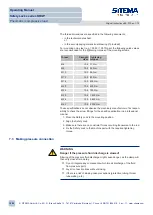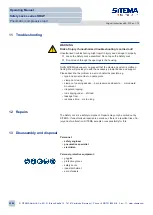
Separate disassembly of clamping rod and Safety Lock
Follow this procedure:
1. Make sure the Safety Lock is under no load.
2. Apply pressure to pressure port L.
ð
The clamping system opens.
3. Disassemble the rod and pull it out of the Safety Lock.
4. Discharge accumulated residual pressures.
5. Disconnect the complete pressure supply from the Safety Lock.
6. Loosen the mounting screws and remove the Safety Lock from the ma-
chine.
13.2 Disposal
There are no electronic components built into the Safety Lock. The only elec-
tronic components are the externally mounted proximity switches (optional
equipment).
Follow this procedure:
1. Remove the proximity switches and dispose of them in accordance with
environmental regulations.
2. Scrap the Safety Lock in its entirety.
14 Technical data sheet
The data is accurate at the time of printing this manual. The latest version is
available at www.sitema.com at any time.
Documents about this
2
Operating Manual
Safety Locks series KRGP
Pneumatic / compressive load
Original instructions BA-S12-en-1-15
© SITEMA GmbH & Co. KG . G.-Braun-Straße 13 . 76187 Karlsruhe (Germany) . Phone: +49(0)721/98661-0 . Fax: -11 . www.sitema.com
28/28

































